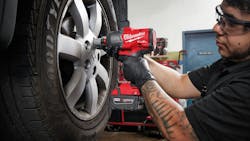When installing expensive, high-diameter tire and wheel packages, the stakes are high. The consequences of failure are even higher.
Take it from Kevin Rohlwing, chief technical officer of the Tire Industry Association (TIA). Rohlwing is the author of TIA’s Automotive Tire Service (ATS) program — the gold standard of tire service training — and one of the world’s foremost experts on tire and wheel installation.
He’s seen the good, the bad and the ugly of tire and wheel service during his 40-plus year career. And one thing he’s learned is that successful tire and wheel installation begins with adherence to the R.I.S.T. procedure.
Translated, the “R” in R.I.S.T means removing debris from a wheel’s mating surfaces. “I” means inspecting all tire and wheel assembly components. “S” refers to snugging lug nuts. And “T” stands for “torque.” Easy, right? Not necessarily.
Your technicians need to understand and master the nuances of each step in the R.I.S.T. process — for their safety, the customer’s safety and the safety and reputation of your business, according to Rohlwing.
When prepping a wheel and tire for mounting, balancing and installation, first remove any and all debris from all mating surfaces, even after pulling brand new wheels from the box, he says.
Then perform a visual inspection “to make sure there isn’t a piece of paper or foam or packing material that got stuck to a mating surface. Inspect all of the wheel components.”
Moving to the next step in the R.I.S.T. process, make sure you’re using the right fasteners. And always, without deviation, snug in a star pattern — starting at the 12 o’clock position, says Rohlwing.
“If the wheel is seated on the hub at 12 o’clock, it’s going to be seated everywhere else. The wheel manufacturers and engineers are going to say, ‘Start at 12, all the time — no exceptions.’
From there, “snug top-bottom-left-right and cross at the center” of the wheel. “Don’t go around in a circle. Don’t go around the horn because the components may not be seated properly.”
Always perform a visual inspection of the lug nuts. Have they been snugged correctly? “If the nuts don’t have a cap on them, you can check the number of threads that protrude from the end of the stud,” says Rohlwing. “You can also spin it. If it wobbles, it isn’t seated right. Make sure the center hole is evenly seated all the way around. Look for any visual clues” that proper seating hasn’t occurred. If you realize that lug nuts have been seated incorrectly, “back off all the lug nuts and then seat it again.”
When it comes to torque — the final stage in the R.I.S.T. process — “you have to get to the torque value that’s specified by the vehicle manufacturer.”
Tools can vary. “There are manual torque wrenches. There are cordless torque wrenches. You want to use something that can be calibrated and something you can have a calibration certificate for.
“The traditional torque wrench is probably the most cost-effective tool, but you have to maintain it and get it calibrated on a regular basis, so if you ever have a wheel-off situation, you can produce a certificate that says, ‘Yes, this device was properly calibrated when I installed the lug nuts,’ which is always good” if you find yourself mired in a lawsuit.
And lawsuits can — and do — happen, says Rohlwing, who has testified as a tire and wheel installation expert in many courtrooms.
“Any time you can produce any kind of documentation in a legal situation, it’s going to be a big help. When you can show that your technicians did it right and used the right torque and used a calibrated wrench that was stored properly, you’re taking away things attorneys like to point out that make little lawsuits into big lawsuits. You need to use something that can be calibrated.”
Finally, after installation of the tire and wheel package has been completed, recommend that customers return to your location for a torque check “within the first five to 50 miles” of leaving your lot, says Rohlwing.
When moving through the R.I.S.T process, take your time. “One of the biggest problems we have in our industry is technicians sometimes feel like they’re on a pit crew at the Daytona 500. If I’m mounting an expensive set of tires and wheels, I’m going to do everything as slowly and deliberately as possible to make sure nothing can go wrong.”
Hopefully, the above information serves as a refresher for your technicians. If not, share it with them immediately. And don’t stop there. Contact TIA at www.tireindustry.org for more guidance. If your technicians haven’t gone through TIA’s ATS program, you should strongly consider enrolling them.
It’s never too late to master the basics of tire and wheel installation. And it’s always a good idea to brush up on the correct procedure. It will benefit your technicians, your customers, your business and ultimately, you.
About the Author
Mike Manges
Editor
Mike Manges is Modern Tire Dealer’s editor. A 28-year tire industry veteran, he is a three-time International Automotive Media Association Award winner, holds a Gold Award from the Association of Automotive Publication Editors and was named a finalist for the prestigious Jesse H. Neal Award, the Pulitzer Prize of business-to-business media, in 2024. He also was named Endeavor Business Media's Editor of the Year in 2024. Mike has traveled the world in pursuit of stories that will help independent tire dealers move their businesses forward. Before rejoining MTD in 2019, he held corporate communications positions at two Fortune 500 companies and served as MTD’s senior editor from 2000 to 2010.

